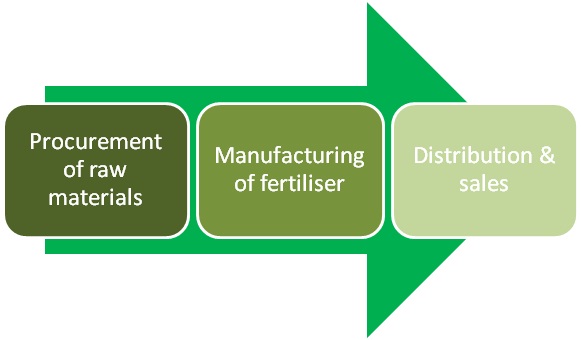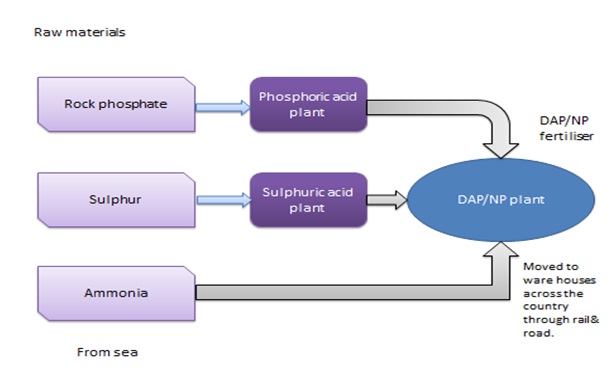- Articles ›
- Operations and IT ›
- The Fertilizer Industry Value Chain Articles
The Fertilizer Industry Value Chain
In India nearly 60% of the population depends on agriculture for livelihood. Fertilizer play important role in agricultural yields. Thus fertilizer industry is one of the important factors that influence the economy of agriculture and rural India. India is the third largest producer of chemical fertilizer in world. Every year our government is spending nearly Rs 800 billion as fertilizer subsidy.
Among all the industries, fertilizer industry is one which is operating on the most complex, uncertain and rapidly changing environment. This uncertainty is due to volatile raw material price in international market, government policy on fertilizer subsidy, monsoon, manufacturing plant conditions, availability of natural gas, coal, etc. In fertilizer industry supply chain consists following functions.

The task of managing the whole supply chain in fertilizer industry becomes difficult due to lot of uncertainties. Let us discuss the various steps of supply chain and about the processes in those steps.

Procurement of raw materials
As the raw materials for a fertilizer industry, minerals like rock phosphate, sulphur are not available in India and the ammonia production in India is also very low, many fertilizer manufacturing companies in India import the raw material required for manufacturing process. This procurement of raw materials involves many procedures involving contracts with suppliers, dealing with government regarding customs, port operation, etc. dealing with external agencies for completing the procedure of imports, transportation of raw materials from port to the plant and storing.
Manufacturing Process
Fertilizer manufacturing comes under process industry. Manufacturing process in process industry like fertilizer industry is more complex than mechanical manufacturing. As the manufacturing process in fertilizer industry cannot be stopped as simply as in mechanical manufacturing, it requires critical planning. The processes are mostly automated due to their nature. So it involves higher degree of advanced technology and engineering. And also to obtain the end product, various processes should be coordinated to follow a specific sequence.
For example, consider the manufacturing process of DAP/NP fertilizer. As you can see, to ensure a uniform production of end products, the intermediate products should be produced accordingly. So it requires high coordination between these processes in various parameters.

Distribution of the finished product
After the fertilizer is ready, it should be ensured that all the fertilizer is available to all potential customers (farmers). Again, in fertilizer industry, it is a difficult task. As the potential customers are distributed throughout the rural areas of the country, the distribution network is large and requires more resources for managing. The uniform production pattern in the plant should be matched with the highly varying demand pattern for different regions of the country. This requires high degree of planning from management and high availability of warehousing facilities.
Normally, the mode of transport preferred is railways due to its low cost and high connectivity to rural areas. So, in India, the distribution of fertilizer and cost of distribution is highly dependent of Indian railways infrastructure and freight charges. Road and sea modes are also used but in a smaller extent.
In India, marketing and sales of fertilizer is an easy function because of the fact that demand exceeds supply. So the product can be sold once it reaches the market. In fertilizer industry, distribution is the main function in marketing.
Central planning
In this fertilizer value chain, the most important function is planning and coordinating of all these important chain functions. In procurement of raw materials, a company has to plan for ordering of raw materials based on demand pattern and production requirement. As buying of raw material involves risk of currency fluctuation and international market price fluctuation, hedging strategies should be adopted to averse these risks. In manufacturing process, production cannot be done accordingly with the demand pattern. So, the production should be planned so to meet the seasonal demand of fertilizers.
And also, the manufacturing plants should meet the safety and environmental standards laid out by the government to carry out the production operations continuously. In marketing, even though demand exceeds supply, estimating demand for different types of fertilizers at different geographical locations and seasons is challenging and complex task.Distribution requires planning and maintenance of distribution network that spread through rural areas.
Supporting Activities
To ensure the steady flow along the supply chain various kind of critical supporting activities, apart from the core activities, are to be performed. Some of them are:
- Power generation (for the consumption of plant)
- Forex management (Hedging to averse the risk of volatile raw material prices)
- Human resource management (Recruitment & Training)
- Administration
- Department for environmental protective measures
- Systems Dept, etc.
Conclusion
As the market for raw materials of fertilizer is oligopolistic at the global level, the prices of raw materials are highly dependent on the environment. So is the price of fertilizers. And also the fertilizer policy of the government, the monsoon pattern, etc. also affects the fertilizer industry. In this type of highly complex and uncertain industry, where the changes cannot be easily predicted and influenced, the only hope to succeed is to develop a competitive advantage by developing strong and supportive supply chain and managing it efficiently by allocating necessary resources for the elements of the supply chain.
This article has been authored by Ganesh Babu from IIM Rohtak.
Views expressed in the article are personal. The articles are for educational & academic purpose only, and have been uploaded by the MBA Skool Team.
If you are interested in writing articles for us, Submit Here
Share this Page on:
What is MBA Skool?About Us
MBA Skool is a Knowledge Resource for Management Students, Aspirants & Professionals.
Business Courses
Quizzes & Skills
Quizzes test your expertise in business and Skill tests evaluate your management traits
All Business Sections
Write for Us